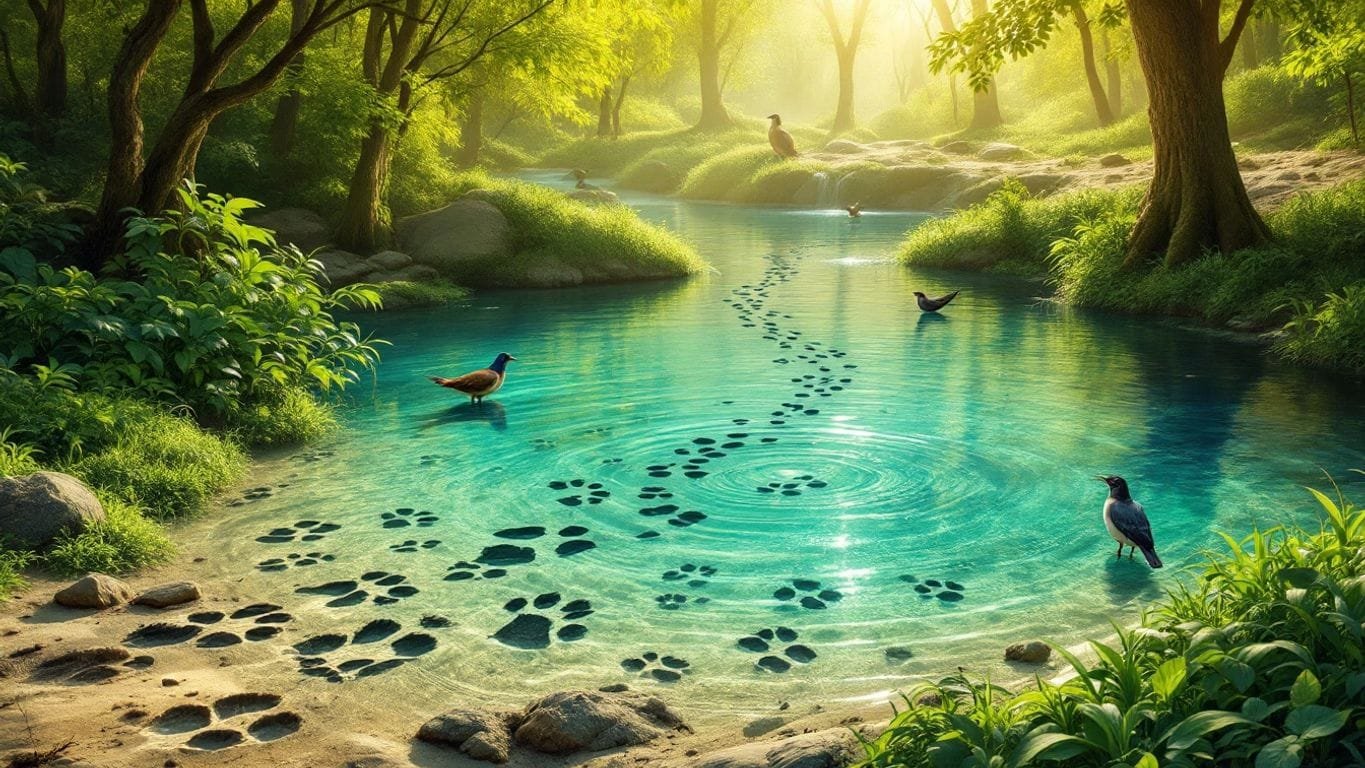Water is essential for wildlife, playing a crucial role in their survival and the overall health of ecosystems.
In this article, we will explore various techniques for scouting and managing water sources to support wildlife conservation.
From understanding the importance of water to utilizing technology for monitoring, these strategies aim to create a sustainable environment for diverse species.
Key Takeaways about Scouting Water Sources for Wildlife
- Water sources are vital for wildlife health and ecosystem balance.
- Identifying natural water sources like streams and ponds is crucial for wildlife management.
- Techniques like rainwater harvesting can enhance natural water availability.
- Creating wildlife ponds requires careful planning and maintenance.
- Community involvement is essential for effective water conservation efforts.
Understanding the Importance of Water Sources for Wildlife
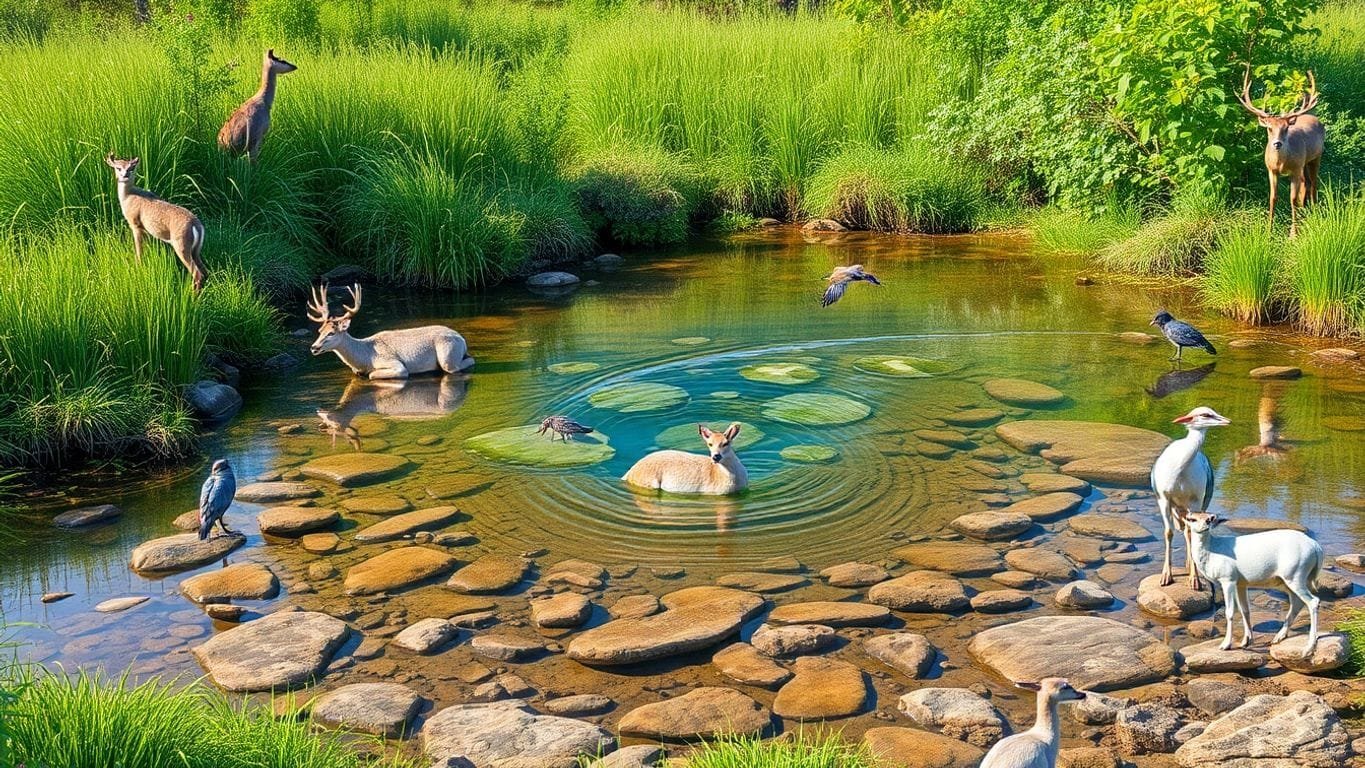
Why Water Sources Matter
Water is a big deal for wildlife.
Without it, many animals struggle to survive.
It’s not just about drinking; animals need water for bathing and cooling down too. By providing accessible water sources, we can help them thrive.
Here are a few reasons why water sources are crucial:
- Drinking: Essential for hydration.
- Bathing: Helps animals stay clean and healthy.
- Cooling: Provides relief during hot weather.
Impact on Wildlife Health
Clean and flowing water means healthier wildlife.
When water sources are in good shape, we see more fish and diverse species. This is vital for maintaining ecosystem health. Here’s how water quality impacts wildlife:
- Healthy populations: Clean water supports diverse species.
- Migration: Animals can travel freely when water is abundant.
- Plant growth: Diverse plants thrive near clean water.
Role in Ecosystem Balance
Water sources play a key role in keeping ecosystems balanced.
They support various life forms and help maintain the natural order. Here’s what we can consider:
- Habitat: Water bodies create habitats for many species.
- Food chain: Healthy water sources support the entire food chain.
- Biodiversity: More water means more life!
In short, water is the lifeblood of our ecosystems. By ensuring clean and accessible water sources, we can support wildlife and promote a balanced environment.
Let’s remember that managing our water sources is not just about conservation; it’s about ensuring a thriving future for all wildlife!
Identifying Natural Water Sources in the Wild
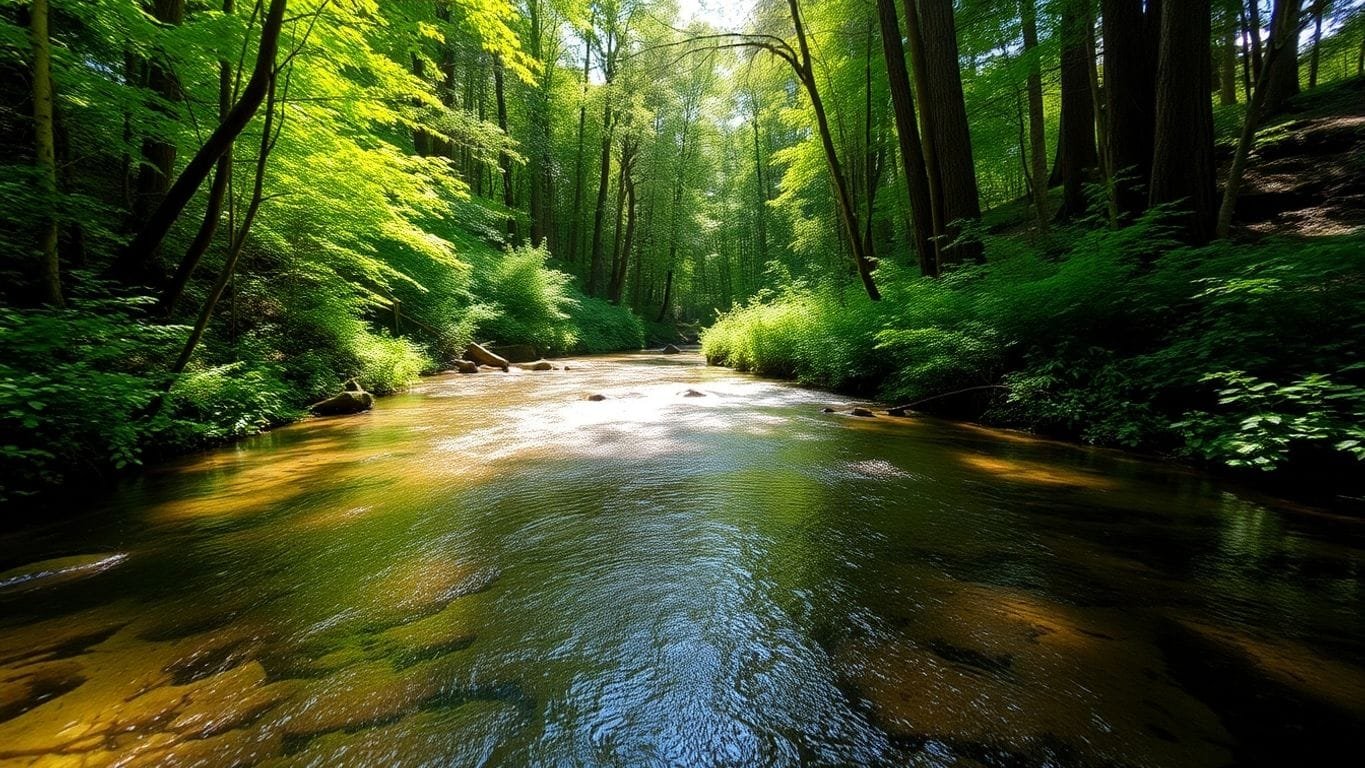
When we’re out in the wild, finding water sources is super important for wildlife.
Water is life, and knowing where to look can make a big difference.
Here are some key types of natural water sources we should keep an eye out for:
Streams and Rivers
Streams and rivers are often the most reliable sources of water.
They’re usually flowing, which means the water is fresher and safer for wildlife.
Here’s what to remember:
- Look for areas where the water flows steadily.
- Check for signs of wildlife activity nearby.
- Be cautious of any potential pollution sources upstream.
Natural Ponds and Lakes
Ponds and lakes can be great spots for wildlife, especially during dry spells. They provide a place for animals to drink and cool off.
Here’s how to identify them:
- Look for larger bodies of water that don’t dry up quickly.
- Observe the surrounding vegetation; lush areas often indicate a healthy ecosystem.
- Check for signs of animal tracks or droppings nearby.
Seasonal Water Bodies
These are temporary water sources that appear during certain times of the year, like after heavy rains. They can be crucial for many species:
- Keep an eye out for puddles or small pools after rain.
- These areas can attract a variety of wildlife, especially during migration seasons.
- Remember, they may dry up quickly, so timing is key!
Finding water sources is not just about the water itself; it’s about understanding the whole ecosystem around it.
By knowing where to look for these natural water sources, we can help support wildlife and maintain a balanced ecosystem. Let’s keep our eyes peeled and our minds open as we explore the great outdoors!
Techniques for Enhancing Natural Water Sources
When it comes to helping wildlife thrive, enhancing natural water sources is key.
These techniques can make a big difference in providing reliable water for animals.
Here are some methods we can use:
Rainwater Harvesting
- Collecting rainwater can be a simple yet effective way to boost water availability.
- We can set up barrels or tanks to gather rain from roofs or other surfaces.
- This not only helps wildlife but also reduces runoff and erosion.
Water Diversion and Retention
- By creating small barriers or channels, we can direct water flow to areas where it’s needed most.
- This can help keep water in certain spots longer, especially during dry spells.
- Using natural materials like rocks and logs can blend these features into the landscape.
Erosion Control Practices
- Erosion can wash away valuable soil and water. We can plant native vegetation to stabilize the soil.
- Techniques like building terraces or using silt fences can also help.
- Keeping the land healthy ensures that water sources remain intact and usable.
By enhancing natural water sources, we not only support wildlife but also promote a healthier ecosystem overall.
In summary, these techniques are not just about adding water; they’re about creating a sustainable environment for all living things.
Let’s get to work on these practices and see the positive impact we can make!
Creating and Maintaining Wildlife Ponds
Choosing the Right Location
When we think about creating a wildlife pond, the location is super important.
We want to pick a spot that’s naturally wet or near other water sources.
Here are some tips:
- Look for low-lying areas that collect water.
- Avoid places too close to roads or human activity.
- Ensure there’s enough sunlight for plants to grow.
Ensuring Water Quality
Keeping the water clean is key!
We need to regularly check the water quality to make sure it’s healthy for wildlife.
Here’s how we can do that:
- Test for pollutants and harmful chemicals.
- Use natural filtration systems like aquatic plants to help keep the water clear.
- Manage algae growth to prevent it from taking over.
Vegetation Management
Managing the plants around our pond is crucial for attracting wildlife. Here’s what we can focus on:
- Plant native vegetation to provide food and shelter.
- Control invasive species that can harm the ecosystem.
- Regularly remove debris to keep the area clean and inviting.
Maintaining a wildlife pond isn’t just about creating it; it’s about keeping it healthy and thriving for all the creatures that depend on it.
By following these steps, we can create a thriving habitat that supports various wildlife species.
Remember, maintenance matters: regular maintenance is key to keeping your pond healthy. Let’s work together to make our wildlife ponds a success!
Implementing Riparian Habitat Improvements
Planting Native Vegetation
When we think about improving riparian habitats, one of the first things that comes to mind is planting native plants.
These plants are great because they provide food and shelter for wildlife. Plus, they help keep the soil in place, which is super important for preventing erosion.
Here are some plants we might consider:
- Willows
- Alders
- Dogwoods
Controlling Invasive Species
Next up, we need to tackle those pesky invasive species.
They can really mess up the balance of our ecosystems. By removing them, we give our native plants a fighting chance.
Here’s how we can do it:
- Identify invasive plants in the area.
- Use manual removal or eco-friendly herbicides.
- Monitor the area regularly to prevent re-growth.
Managing Water Levels
Lastly, managing water levels is crucial for a healthy riparian habitat.
We want to make sure that wildlife has access to water without flooding their homes. Here are some tips:
- Create small dams to control flow.
- Use natural barriers to slow down water.
- Regularly check and adjust as needed.
By improving riparian habitats, we not only support wildlife but also protect our water quality. For instance, riparian buffers protect water quality by intercepting sediment and pollution from agricultural fields, residential lawns, roadways, and other sources. This is a win-win for everyone involved!
Monitoring and Maintaining Water Quality
Regular Inspections and Repairs
To keep our water sources healthy, we need to check them regularly.
Here’s what we can do:
- Look for signs of pollution like trash or strange smells.
- Check the water levels to ensure they’re stable.
- Repair any damage to the water source, like broken banks or erosion.
Testing for Pollutants
We can’t just assume our water is clean.
Testing is key! Here’s how we can do it:
- Collect water samples from different spots.
- Use simple test kits to check for harmful substances.
- Compare results with approved water quality guidelines to see if we’re in the clear.
Managing Algal Blooms
Algal blooms can be a big problem for wildlife. Here’s how we can tackle them:
- Monitor water temperature and nutrient levels.
- Use natural methods to control algae, like adding beneficial plants.
- Educate the community about reducing fertilizer use near water sources.
Keeping our water clean is not just about the wildlife; it’s about us too! Healthy water means a healthy ecosystem for everyone.
By following these steps, we can ensure that our water sources remain vibrant and full of life.
Let’s work together to protect our waters!
Utilizing Technology for Water Source Scouting
When it comes to scouting water sources for wildlife, we can’t overlook the power of technology.
Using modern tools can make our efforts more effective and efficient.
Here are some ways we can leverage technology:
Using Trail Cameras
- Monitor wildlife activity: We can set up trail cameras near water sources to see which animals visit and when.
- Gather data: This helps us understand patterns and make informed decisions about conservation efforts.
- Remote viewing: We can check the cameras from our phones or computers, saving us time.
Employing Drones
- Aerial surveys: Drones allow us to survey large areas quickly, spotting water sources that might be hard to reach on foot.
- Mapping: We can create detailed maps of the terrain, helping us plan better.
- Monitor changes: Drones can help us track changes in water levels or vegetation over time.
GPS and Mapping Tools
- Precise location tracking: GPS tools help us mark the exact locations of water sources.
- Data collection: We can gather data on water quality and quantity, which is crucial for wildlife health.
- Planning: These tools assist in planning conservation projects by showing us where to focus our efforts.
By embracing technology, we can enhance our scouting efforts and contribute to better wildlife management.
In summary, utilizing technology like trail cameras, drones, and GPS tools can significantly improve our ability to scout and manage water sources for wildlife. Let’s embrace these innovations to make a real difference!
Collaborating with Conservation Agencies and Experts
When it comes to protecting our wildlife and their habitats, working together with conservation agencies and experts is key.
They have the knowledge and resources that can really help us make a difference.
Here’s how we can get involved:
Seeking Expert Advice
- Reach out to local conservation agencies for guidance on best practices.
- Attend workshops or seminars to learn from experts in the field.
- Don’t hesitate to ask questions; they’re there to help us!
Participating in Local Conservation Programs
- Join community programs that focus on habitat restoration and wildlife protection.
- Volunteer for events that promote awareness about local wildlife needs.
- Collaborate with schools or organizations to spread the word about conservation efforts.
Funding and Grants
- Look for grants that support conservation projects in our area.
- Partner with agencies that can provide financial assistance for habitat improvement.
- Consider fundraising events to gather resources for local conservation initiatives.
By teaming up with conservation experts, we can enhance our efforts and ensure a healthier environment for wildlife.
In short, collaborating with conservation agencies not only boosts our knowledge but also strengthens our impact on wildlife conservation. Let’s make a difference together!
Balancing Water Needs with Other Habitat Requirements
Integrating Food Plots
When we think about wildlife, we often focus on water, but food is just as crucial.
To create a balanced habitat, we should:
- Plant a variety of crops that mature at different times.
- Include both annuals and perennials for a steady food supply.
- Ensure that food sources are close to water to attract wildlife.
Providing Shelter and Cover
Wildlife needs places to hide and rest. Cover can be anything from thick bushes to fallen logs. Here’s how we can help:
- Leave some areas wild and uncut.
- Create brush piles for small animals.
- Plant native trees and shrubs that provide shelter.
Ensuring Space and Arrangement
Animals need space to roam and find food without competing too much. We can:
- Design habitats that minimize travel between food, water, and cover.
- Avoid overcrowding by managing the number of animals in an area.
- Create edges where different habitats meet, as these spots are often rich in wildlife.
By balancing water needs with food and shelter, we can create a thriving environment for wildlife. Remember, habitat conservation for wild species is one of the most important issues facing the environment today!
Engaging the Community in Water Source Conservation
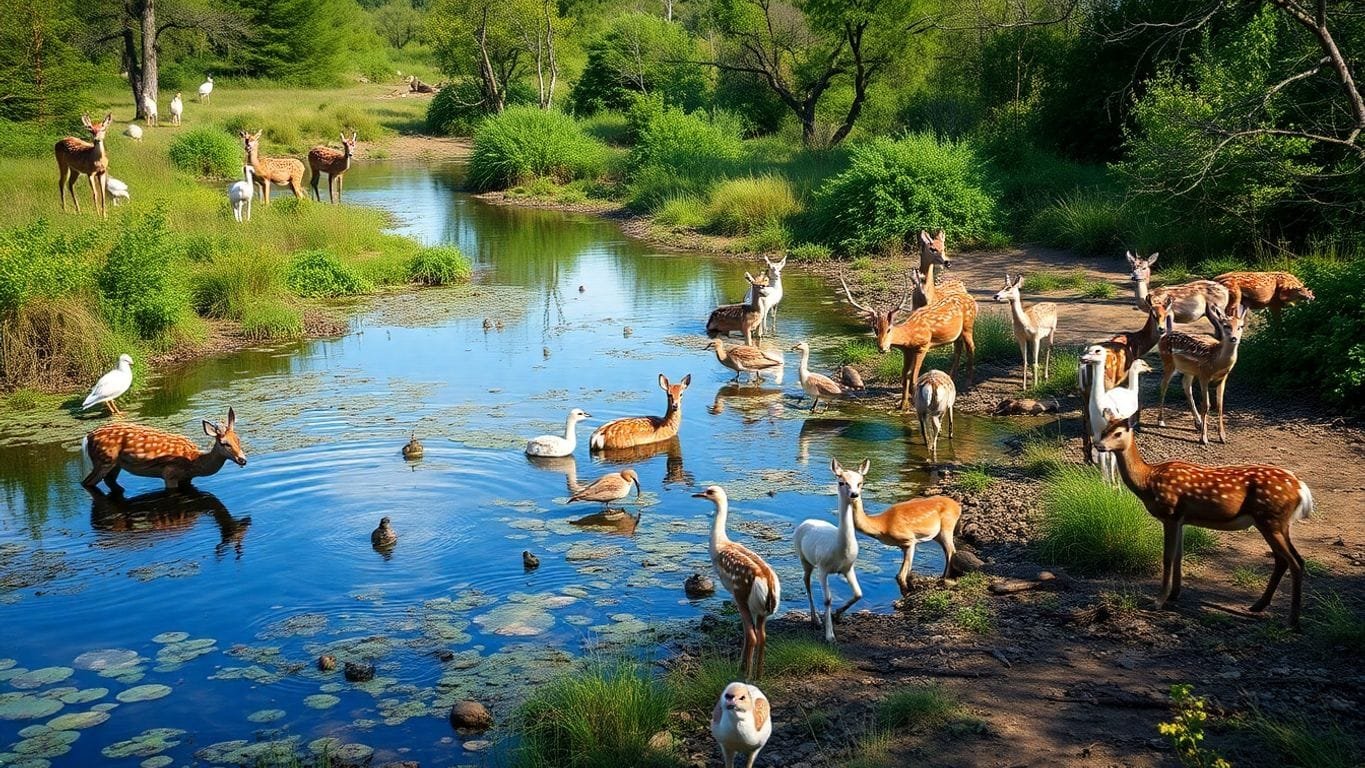
When it comes to conserving our water sources, we can’t do it alone.
By working together, we can make a real difference in protecting our wildlife and their habitats.
Here are some ways we can engage our community:
Educational Outreach
- Workshops and Seminars: Organize events to teach people about the importance of water conservation.
- School Programs: Partner with local schools to educate students about wildlife and water sources.
- Social Media Campaigns: Use platforms to spread awareness and share tips on conservation.
Volunteer Programs
- Clean-Up Days: Set up community clean-up events at local water sources.
- Tree Planting Events: Encourage community members to plant trees that help maintain water quality.
- Wildlife Monitoring: Get volunteers involved in tracking local wildlife populations and their health.
Community-Led Projects
- Local Conservation Groups: Join or form groups focused on specific water sources in our area.
- Funding Initiatives: Work together to apply for grants that support conservation projects.
- Collaborating with Local Organizations: Partner with groups like Canadian fishing conservation organizations to enhance our efforts.
By engaging our community, we not only protect our water sources but also foster a sense of responsibility and connection to our environment. Together, we can create a sustainable future for wildlife and ourselves!
Adapting to Seasonal Changes and Climate Variability
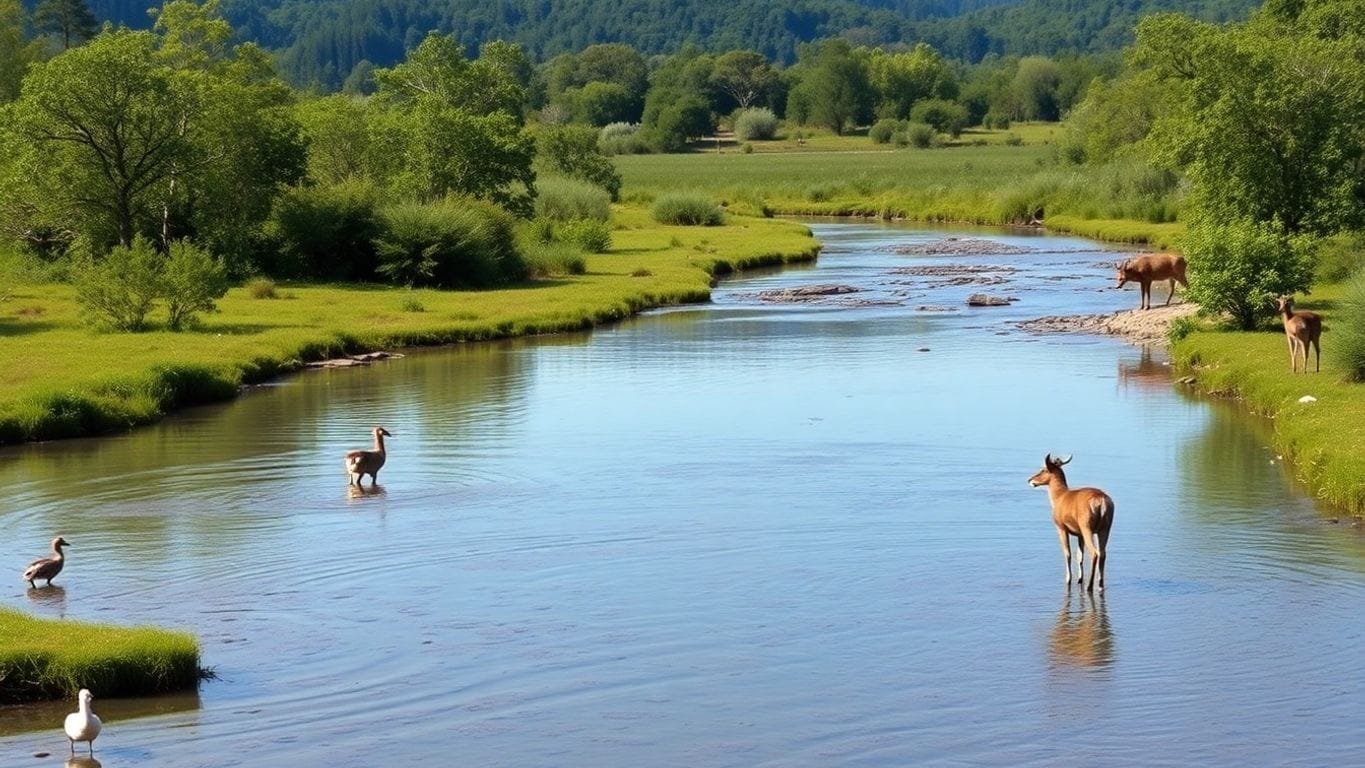
Planning for Droughts
When we think about wildlife, we need to consider how droughts can affect water sources.
Here are some things we can do:
- Create backup water sources like ponds or tanks.
- Use drought-resistant plants in our habitats.
- Monitor weather patterns to anticipate dry spells.
Managing Flood Risks
Flooding can be just as harmful as droughts. To keep our wildlife safe, we should:
- Identify areas prone to flooding.
- Build barriers or levees to protect habitats.
- Create channels to redirect excess water.
Adjusting Conservation Strategies
As seasons change, so should our strategies. We can:
- Regularly assess the health of our water sources.
- Adapt our wildlife management plans based on seasonal changes.
- Collaborate with local experts to stay updated on best practices.
In the end, adapting to seasonal changes is crucial for maintaining healthy wildlife populations. By being proactive, we can ensure that our conservation efforts are effective and sustainable.
By keeping these points in mind, we can better support our wildlife through the ups and downs of nature. Let’s work together to make a difference!
Wrapping It Up: The Importance of Water Sources for Wildlife
In the end, scouting for water sources is super important for keeping wildlife healthy and happy.
By knowing how to find and manage these water spots, we can help animals thrive in their habitats. Whether it’s creating ponds, improving natural streams, or planning food plots, every little bit helps.
Plus, when we take care of our land, we’re not just helping wildlife; we’re also making sure future generations can enjoy nature too.
So, let’s get out there, do our part, and make a difference for the wildlife around us!
Frequently Asked Questions
Why is water so important for wildlife?
Water is essential for animals to drink and stay healthy. It also helps plants grow, which many animals rely on for food.
What types of natural water sources can I find in the wild?
You can find streams, rivers, ponds, lakes, and even seasonal water bodies that appear during certain times of the year.
How can I improve natural water sources for wildlife?
You can collect rainwater, manage water flow, and prevent soil erosion to help maintain these water sources.
What should I consider when creating a wildlife pond?
Choose a good spot, check the water quality, and think about what plants will grow around it.
How can I enhance riparian habitats?
Plant native plants, control weeds, and manage water levels to support wildlife in these areas.
What steps can I take to monitor water quality?
Regularly inspect water sources, test for harmful substances, and manage algae growth to keep water clean.
How can technology help in scouting water sources?
Using trail cameras, drones, and GPS tools can make it easier to find and monitor water sources.
How can my community get involved in water conservation?
Communities can engage in educational programs, volunteer projects, and local conservation initiatives to help protect water sources.

